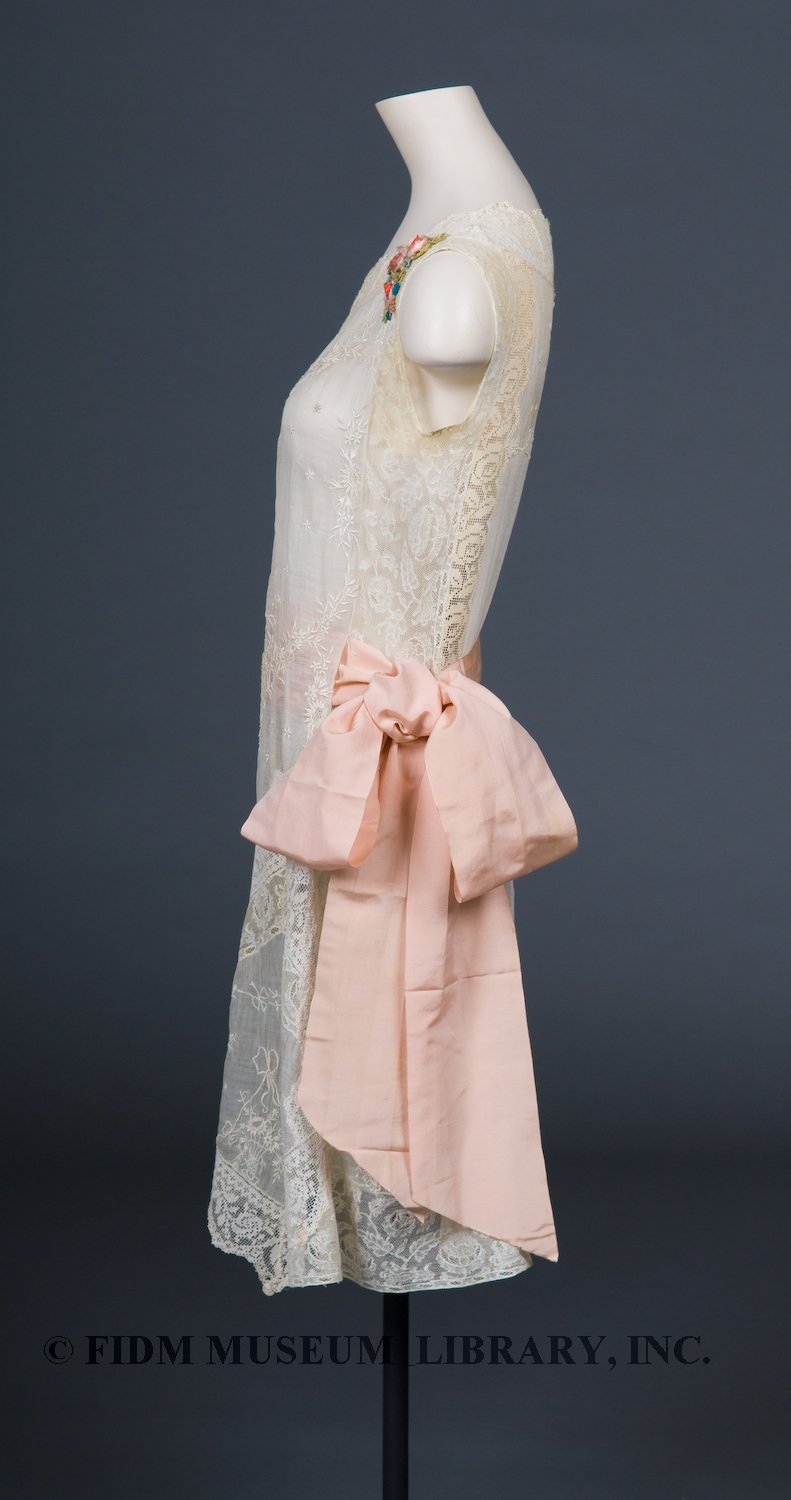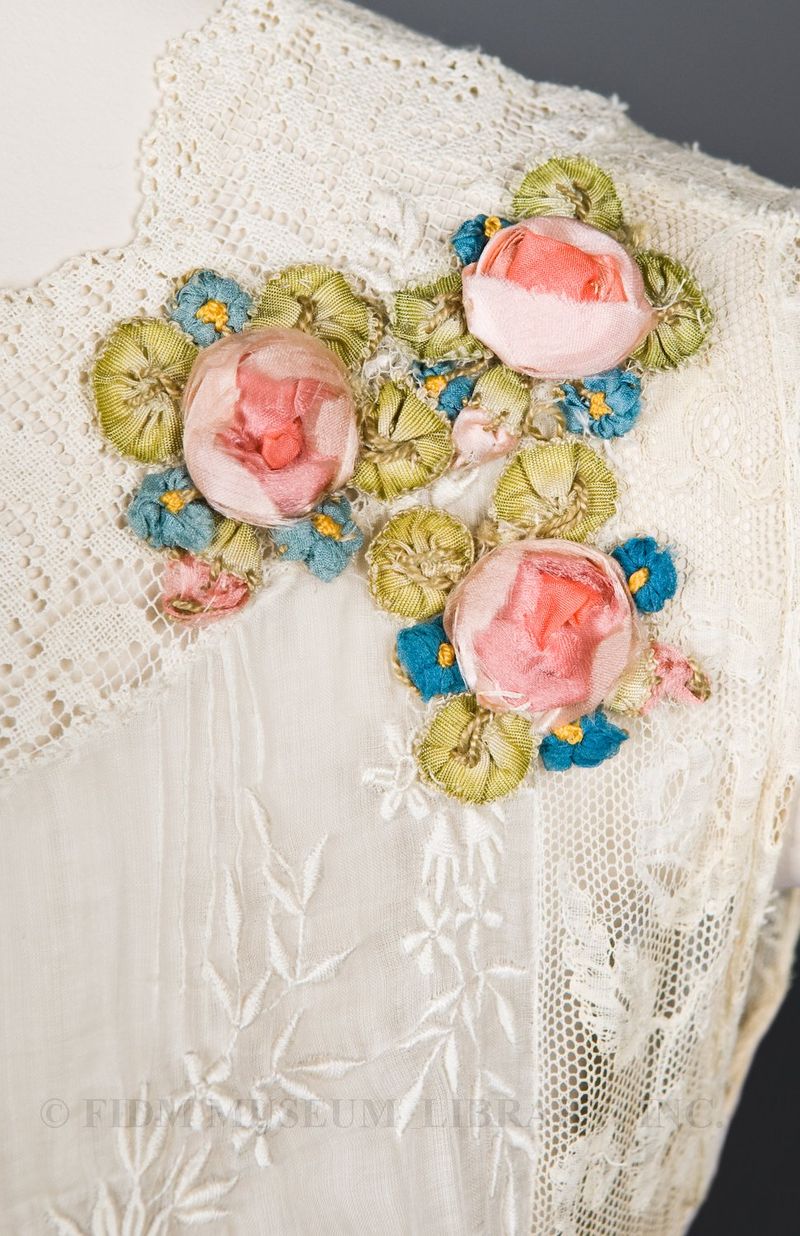If you’re looking for a research project, here’s a great one for you! See if you can add anything new to the existing information about the Boué Soeurs, the pair of French sisters who designed this lingerie-style dress intended for a young girl.
 Girl’s dress
Girl’s dress
Boué Soeurs
c. 1924-25
Gift of Lloyd Costen
2006.876.3AB
According to the very few available sources, sisters Madame Sylvie Montegut and Baronne Jeanne d’Etreillis worked together under their maiden name Boué. Opening first in Paris in 1899, the sisters later opened a branch store in New York. Their designs were extremely feminine, incorporating fine hand-made lace and delicate embellishments such as embroidery and the ribbon flowers seen on the FIDM Museum example. Filet Boué, a floral patterned lace worked on a mesh ground developed by the Boué Soeurs own lacemakers, became a signature of the house. The sisters were also noted for use of gold and silver textiles, which they had to purchase from theatrical supply companies. This same source suggests that Boué Soeurs went out of business in the early 1930s.1
A search of historic newspapers using the research database Proquest (thank you FIDM Library!) revealed some tantalizing details and gave a somewhat more complete picture of their career. In 1915, Madame la Baronne d’Etreillis opened the New York branch of the Boué Soeurs. In December of 1915, the Boué Soeurs ran afoul of United States Customs and Immigration for importing between 50 and 100 French dresses without paying the required taxes. Immigration became involved because Boué Soeurs attempted to bring a group of workers from France into the United States without the proper documentation. In July of 1916, charges were dropped after both Boué sisters spent a day in jail and the company paid a fine of $2,500. Rather than spending 24 hours in an actual jail cell, the sisters were allowed to do their time in an unused office.
According to the articles unearthed via Proquest, Boué Soeurs were actually in business until the mid-1950s. Their Paris salon closed during the years of World War II, but was reopened in 1948 before shuttering permanently in the early 1950s. The New York branch remained open longer, probably closing sometime in 1956. Press coverage reveals that the Boué aesthetic was remarkably consistent. Favoring soft colors such as pale blue, coral and cream paired with their trademark laces and metallic accents, the Boué aesthetic was always dainty, feminine and decidedly romantic. Garment sketches reveal that the silhouette of their garments changed with the times, while fabric and embellishment helped maintain the characteristic Boué look. A 1931 Los Angeles Times article claimed that the “Boué Soeurs always have stood for the elegant, the artistic and the feminine in dress.”2
Due to their extensive use of hand-made laces and sumptuous fabrics, Boué gowns were very pricey. In 1926, The Washington Post posed the question, “How many dollars worth of clothes can a woman wear at one time?”3A young female reporter was sent to New York to answer this question. She purchased a Boué Soeurs evening gown of white velvet with a Venetian lace underskirt, ermine-trimmed collar and a cascade of ribbon roses at the left shoulder for $2,000. According to this currency converter, that would be approximately $25,000 today. By the end of her shopping spree, the reporter had spent $53,275 (about $650,000 today) on all the elements of a complete evening ensemble.
Though they continued to design throughout the 1940s and 1950s, the Boué Soeurs aesthetic did not develop beyond that which was popular in the 1920s and early 1930s. In 1946, they presented a robe de style, a style of dress popular in the 1920s. Coverage of a 1956 fashion show called their designs decidedly nostalgic and indicated that most of the audience members were older women who had a long-standing relationship with the house. There was no mention of the sisters after 1956, which is long after the 1930s end date proposed by academic sources.
The Boué Soeurs are just one example of a formerly important design house that has passed into obscurity. As suggested by what we were able to find on the Boué Soeurs, there are many fascinating stories out there, waiting to be told. Let us know what you find, as we are always interested to hear about ongoing research projects!
1 Milbank, Caroline Rennolds. Couture: The Great Designers. New York: Stewart, Tabori & Chang. 1997.
2 Gray, Olive. “Fine Gowns From Paris Exhibited” Los Angeles Times 3 Nov. 1931.:A6.
3 “In Her $53, 275 Worth of Clothes” The Washington Post 21 Feb. 1926.:SM4.





Dear god that’s beautiful. If you hear any more about this duo, please fill us in. I’m so curious! Have you tried that guidebook to Paris from the 1930s? They had some very helpful on Myrbor when I was doing some research. If you think it would be helpful, let me know and I’ll get you the reference.
That dress is absolutely breathtaking!
I am the grand-daughter of Baroness d’Etreillis. I was born in 1945 so I knew my grandmother and great-aunt at the end of their lives. Sylvie Montegut, who was the creative force behind most of the designs, died of cancer in November of 1953 at the age of 81. Jeanne d’Etreillis, who opened and ran the stores, and took the collection to the courts of the crowned heads of Europe before World War I, died of congestive heart failure in June of 1957, also at 81. She had closed the business 3 months before she died.
I would be happy to answer your questions about Boue Soeurs and the two sisters who created the business from nothing more than their genius and their faith in themselves. Please send your questions to my email address below. I will tell you quite honestly if I don’t know the answer to your question: I am a historian by training and I don’t believe in making things up. I have advanced arthritis so if there is a bit of a delay in my answering your message it just means the arthritis is acting up.
CR
It is so delightful to see your comment! I hope you enjoyed seeing this Boue Soeurs creation. It must have been fascinating to know these two creative women. Did you have a sense of their talents as a child, or did you learn about their design career as an adult?
Thanks for taking the time to contribute to our knowledge of these talented sisters!
I’m thrilled to see some information on the Soeurs Boué as I have long thought their designs were unusually delicate and feminine, even for the Edwardian period. Their use of ribbon embroidery and lace was especially beautiful. It’s obvious they loved and respected handwork. Thank you for posting the pictures of that exquisite dress. If Ms. Roussel is willing to furnish more details on the sisters’ history, especially in America, I would love to read about it.
The dress is stunning. And I want to thank again Christine for taking the time to comment. It is such an honor to interact with the grand-daughter of a legend. What a blessed life to be the grand-daughter of such an amazing person.
I am the grandaughter of Sylvie Boue Montegut. Sylvie’s son, Philippe, my father, told us many endearing stories of my grandmother and great aunt, who had both passed before I was born. Just to add to your information, the sisters were known as Les Irondelles de la Dentelle, for their work with lace. The rose that decorated many of their creations was their signature. You are probably already aware that my father contributed what he had left of their creations to The Metropolitan Museum’s costume collection in New York.
All the best,
Diane Montegut
I am excited to find information on the box of photos I aquired, with pictures from the twenties, of a model named Marion Van Tassel, the photos show her in many of the Boue Soeurs. I have some magazine ads also showing other models.
I have a copy of Les Modes magazine, No. 156, “No. de Noel” Decembre 1913. The cover has a plate entitled Mme. Marthe Regnier, Habillee par Boue Soeurs (pardon absence of accents, s.v.p.). The plate is attributed to Typogravure Goupil of France. I can find little information about the magazine, but the illustration does have the ‘signature’ roses on the dress (two, one at bodice, one at hem). Very interesting ensemble. Wish I could upload a copy of a scan.
Susan, that sounds interesting. We’d love to take a look at the image. If you’re on Facebook, you can post the scan on our Facebook page. You can find us here: https://www.facebook.com/FIDMMuseum
Hello Diane Montegut and Christine Roussel,
I have acquired many professional pictures from the lead poseur of Boue’ Soeurs, shown in beautifully designed clothing of Sylvie and Jeanne. A book is in the works and I would like to talk to you both, in person if possible.. Thank you. Oh I realize the 100 year anniversary is upon us..
Diane and Christine, my email address is denisemariechirco@gmail.com
I would love to find out more! I have one of these dresses. I bought it 11 years ago and wore it as my wedding dress.
Hi Stephanie,
How exciting to have a Boué Soeurs design as your wedding dress! We would love to see a photo – feel free to post to our Facebook page at https://www.facebook.com/FIDMMuseum.
Diane Montegut and Christine roussel…I believe we may be related somehow. My grandfather was Jacques Maurice Charles boue’ from castlendaury France …my great grandmother was Katherine soeurs stouff also from France. I would love to connect with you and share what I know of my family.
First, I don’t “do’ facebook. If you wish more details and images, email me please.
Yes, I have information to add on these French designers. I own a pair of 1920s underpants made by them. Needless to say, rare and remarkable. As well, I have a Hollywood publicity still in which Mary Philbin is wearing one of their gowns. It was imported by Vogue & Co of Los Angeles. There is an April 1923 ad Vogue & Co. in the LA Times. Let me know if you are interested in knowing more.
FYI I have one of the largest brassiere collections in North America… antique, vintage, modern, designer, “mile-stone”. From around the world. For instance, I have all of Gernreich’s styles, most in original packaging including his Thong Bra. We can talk about that too if you like.
You are welcome to contact our curators through our website to continue this conversation! Thanks…